| A | B |
|---|
| The ___ consists of the Sun, planets, _________ planets, and all the other bodies that orbit the Sun. | Solar System, dwarf |
| In order to be considered a planet, an object needs to orbit the Sun, be ____ due to having enough gravity, and must have ____________. | round, cleared its orbit of smaller objects |
| A rotating cloud of gas and dust from which a star and its planets can form is called a(n) ______. | Solar Nebula |
| The ______ States that the Sun and the planets condensed at about the same time out of a rotating cloud of gas and dust. | Nebular Hypothesis |
| About how long ago did the Solar System first start forming? | 5 billion years ago |
| Within the contracting solar nebula, energy from ___________ and pressure from __________ caused the center of the solar nebula to become _______ and denser. | collisions, gravity, hotter |
| When temperatures at the center of the newly forming Sun reached ____________ degrees Kelvin, a type of nuclear reaction called ____ began using ____ as fuel. | 10 million, fusion, hydrogen |
| Of all the matter in our solar system, the Sun used up ____ % of it when it was being formed. | 99% |
| While the Sun was forming, small bodies of matter called _________ merged through collisions and gravity to form larger bodies called _________. | planetesimals, protoplanets |
| If an object outside of the Sun ended up orbiting a planet, it was called a(n) _____. | moon |
| If an object orbiting the Sun was big enough to be round but not big enough to clear out or capture into orbit all the smaller chunks of matter in its orbit, it was called a(n) ______. | Dwarf Planet |
| Which space object was considered to be a planet but recently got demoted to dwarf planet status? | Pluto |
What can the dark lines in the absorption spectrum shown in the lower right corner tell us about the Sun?, 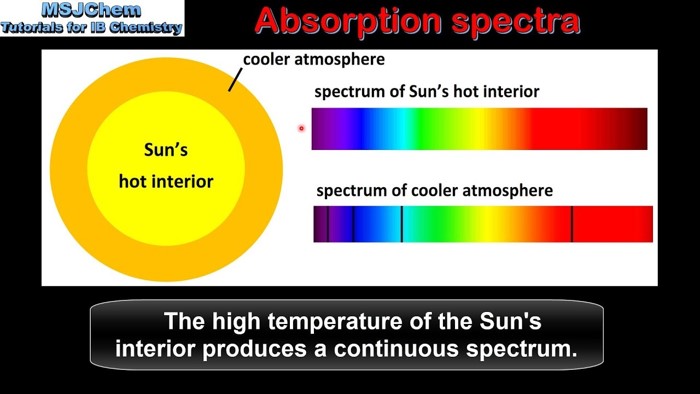 | Which elements can be found in the Sun, 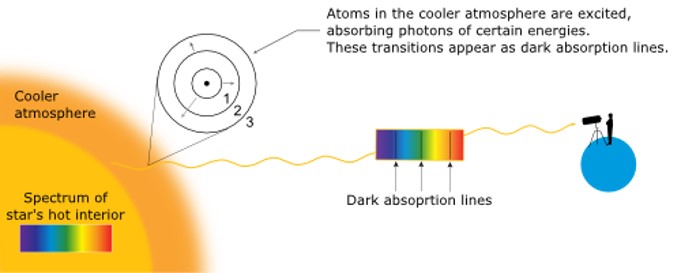 |
| About 75% of the Sun's mass is made of _____ , 24% is ______ and the remaining 1% includes ____. | hydrogen, helium, almost all of the other chemical elements (The other elements besides hydrogen and helium must have been made inside very large stars with an element bigger than iron being made during a supernova explosion. The solar nebula that formed the Sun and our solar system included these elements that came from an exploded star) |
| Which element or elements are fusing together to give off the energy from the Sun? | Hydrogen (toward the end of the Sun's life, it will get hot enough to start fusing helium elements as large as carbon, but right now, it is only hot enough to fuse hydrogen to create helium) |
When 4 hydrogen nuclei fuse to form a helium nucleus, the helium nucleus weighs a little less that the hydrogen nuclei that made it up. What happened to this "lost" mass?, 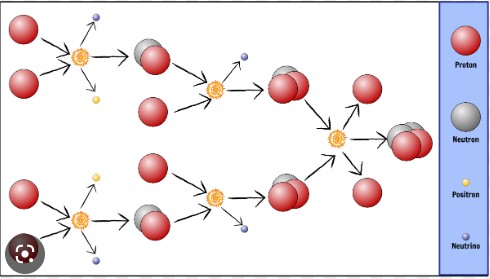 | It was converted into energy (Einstein's equation, E=mc2, shows that a small amount of mass can be converted into a large amount of pure energy) |
| Inside the Sun, hydrogen nuclei fuse together to produce _______ nuclei plus a lot of ______. | helium, energy,  |
| Write the equation for how mass can be converted into energy (and visa versa). | E=mc2 (The two is a superscript, so it should be read as "squared")) |
| In which layer or layers of the Sun does nuclear fusion take place? | the core, 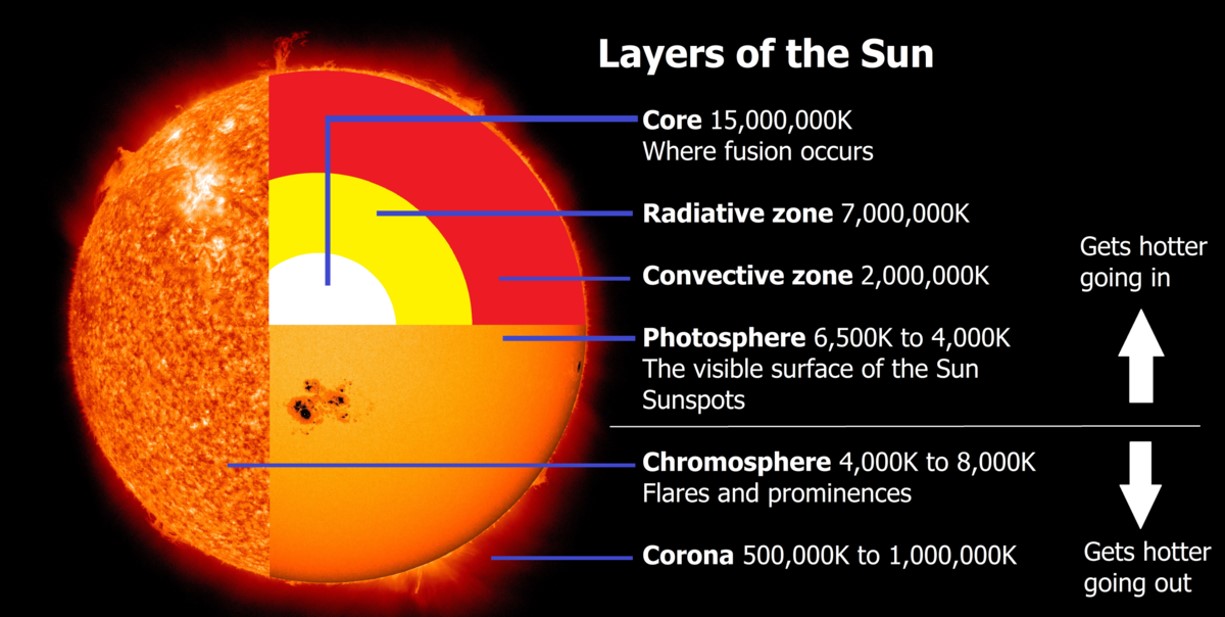 |
| The interior of the Sun is _______ K. | 15 million K |
| The surface of the Sun is about ______ K | 6000K |
| Out of the four states of matter, which state is the matter within the Sun categorized as? | Plasma (Plasma is matter that is so hot that the electrons no longer stay in orbitals around the atom. They are stripped away and move freely) |
| Which layer of the Sun has energy going through it in the form of electromagnetic waves that bounce off of or are absorbed and re-emitted in all directions, making it take a long time for energy to get through this layer? | Radiative Zone, 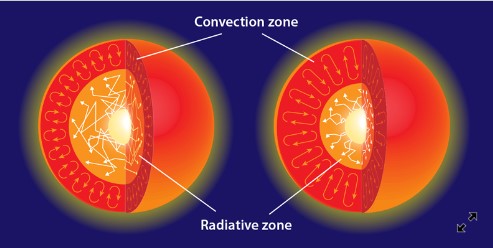 |
| When gases or fluids move heat energy because they expand and rise toward a surface when heated, this process is called _____. | convection |
| Which zone of the Sun has gases that rise toward the surface, cool off, sink back toward the hotter interior, heat up again, and rise again forming a looping pattern of gas movement? | Convection Zone,  |
| Name the 3 interior layers of the Sun, starting with the one in the middle and ending with the outermost one. | Core, Radiative Zone, Convection Zone,  |
| Name the 3 layers of the Sun's atmosphere, starting with the one that can also be considered the surface of the Sun and ending with the one that is furthest out. | Photosphere, Chromosphere, Corona,  |
| Which layer of the Sun is usually considered to be the Sun's surface? | Photosphere (Which is strange because it is also considered to be the inner-most layer of the the Sun's atmosphere, but when you look at the light coming from the Sun, most of it is coming from the photosphere, so we see that as its surface),  |
| Which thin layer of the Sun's atmosphere glows with a reddish color, most likely from energized hydrogen that is emitting the reddish wavelengths typical of hydrogen emission? | Chromosphere,  |
| Which layer of the Sun's atmosphere is the hottest? | The Corona (Which is strange because it is the furthest away from the interior of the Sun, but it is believed to have something to do with energy from the interior of the Sun travelling along magnetic field lines into the Corona region) |
| Cooler less bright areas on the Sun's surface are called _____. | Sunspots, 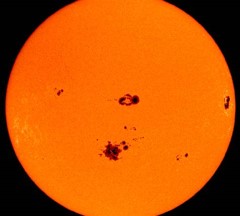 |
What are the dark areas on this photo of the Sun's surface called?,  | Sunspots,  |
| Solar flares, prominences, and coronal mass ejections are all types of ______. | solar eruptions |
| The most violent and hot type of solar eruption is called a(n) _____. | solar flare |
| Solar eruptions that disturb Earth's magnetic field are called ______. | geomagnetic storms |
| If the power grid blacks out and come communications satellites go dead, the most likely cause is a(n) _______ storm. | geomagnetic |
The yellow lines in the picture represent ______., 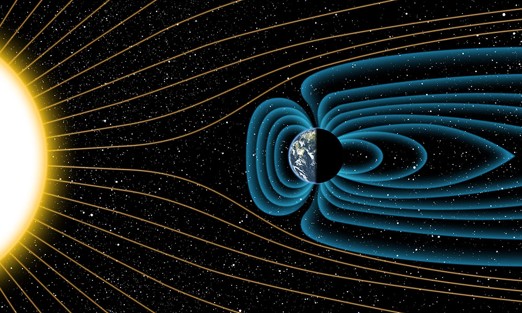 | solar winds,  |
The blue lines in the picture represent ______.,  | Earth's magnetic field (be sure not to forget to say that it's Earth's magnetic field, because the Sun also has a magnetic field),  |
| When charged particles from solar winds get funneled down into Earth's atmosphere near the north and south poles, the gases in our atmosphere start to glow. This glowing phenomenon is called a(n) ______. | aurora (The one in the northern hemisphere is called the Aurora Borealis or "Northern Lights" while in the southern hemisphere, it's called the Aurora Australis, or "Southern Lights."), 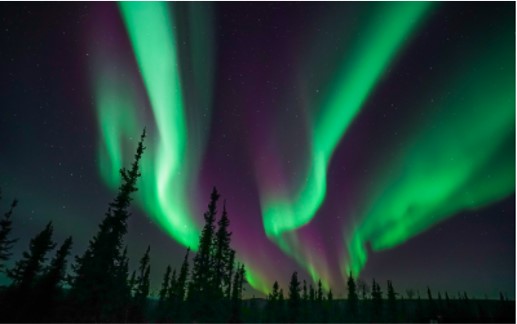 |
This picture is showing a(n) ____.,  | aurora (The one in the northern hemisphere is called the Aurora Borealis or "Northern Lights" while in the southern hemisphere, it's called the Aurora Australis, or "Southern Lights."),  |
| The Sun isn't expected to run out of hydrogen fuel for another ______ years. | 5 billion |
| After the Sun runs out of hydrogen fuel, it will contract, heat up to more than 100 million K, and start burning ______ for fuel instead. | helium |
| The largest element that the Sun will ever be able to make through nuclear fusion is ______. | carbon (Once the Sun leaves the main sequence and heats up past 100 million K, it will start fusing helium. The largest element that can be formed this way is carbon and our Sun is not expected to ever get hot enough to fuse carbon into even heavier elements) |
| After the Sun runs out of hydrogen for fuel, it will get much bigger, becoming a ________. | Red Giant, .jpg) |
| What will the Sun become after it runs out of helium for fuel? | A white dwarf, .jpg) |